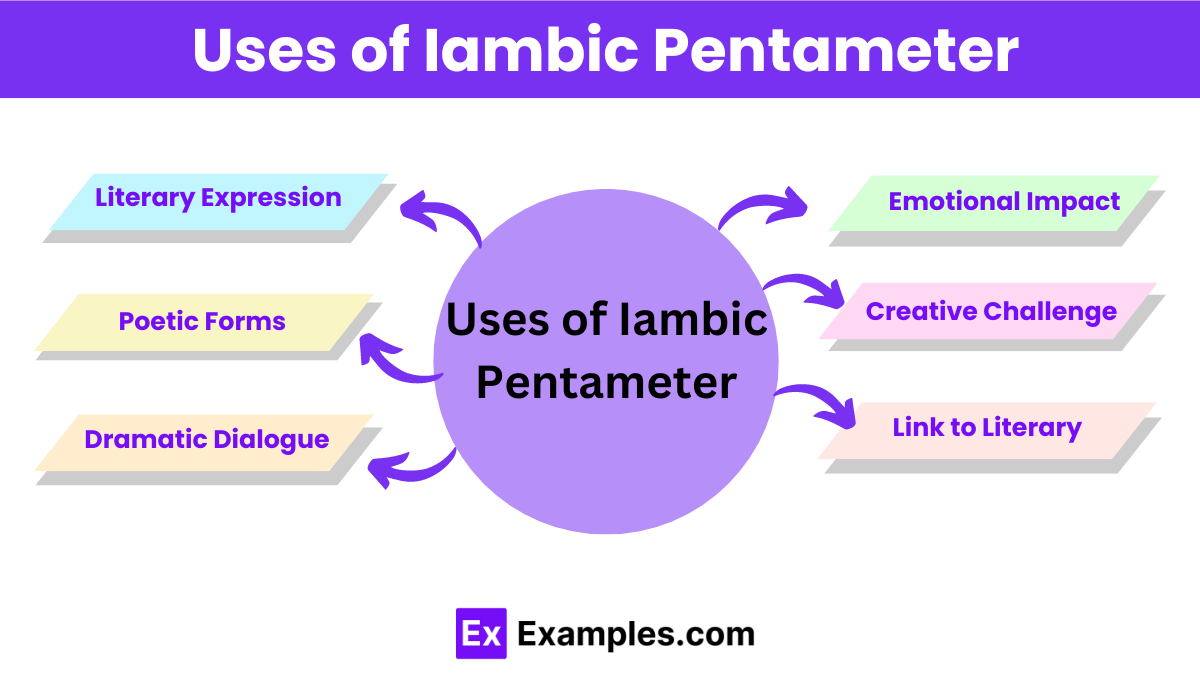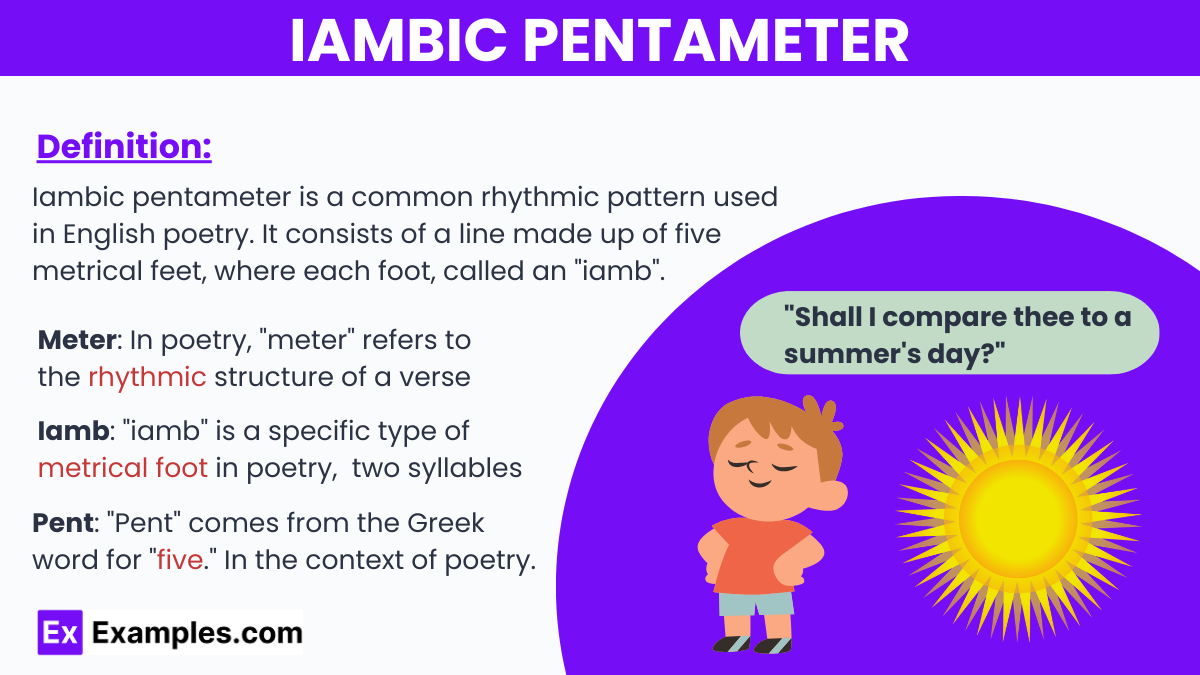Iambic Pentameter – Definition, How to Write, Examples, Uses
Iambic pentameter is a metrical pattern commonly used in traditional English poetry, where each line consists of five pairs of syllables, known as iambs. An iambic foot consists of one unstressed syllable followed by one stressed syllable, creating a rhythmic “da-DUM” pattern. This structure lends itself to a natural and flowing cadence, resembling the natural rhythm of English speech. Writers have employed iambic pentameter for centuries, from the works of Shakespeare to modern poets, due to its versatility and ability to convey a sense of harmony and balance in verse. Its rhythmic regularity allows for a wide range of expression, from solemnity and introspection to humor and passion, making it a cornerstone of English poetic tradition.
What is Iambic Pentameter?
Iambic pentameter is a common rhythmic pattern used in English poetry and dramatic verse. It consists of a line made up of five metrical feet, where each foot, called an “iamb,” has two syllables. Typically, the first syllable is unstressed, followed by a stressed syllable. This pattern creates a rhythm that sounds like: da-DUM da-DUM da-DUM da-DUM da-DUM.
Characteristics of Iambic Pentameter
- Rhythmic Structure: The consistent alternation between unstressed and stressed syllables provides a natural flow, making it particularly suited to the English language.
- Versatility: It’s used in various forms of poetry, including sonnets and blank verse.
- Famous Usage: William Shakespeare extensively used iambic pentameter in his plays and sonnets, making it a hallmark of classical and Elizabethan poetry.
How to write Iambic Pentameter
Writing in iambic pentameter is a skill that combines a structured rhythmic pattern with the freedom of poetic expression. It’s widely recognized for its use in Shakespeare’s plays and sonnets. Here’s a step-by-step guide to mastering this poetic form:
Step 1: Understanding the Basics
- Understand an Iamb: An iamb is a metrical foot consisting of two syllables. The first syllable is unstressed, followed by a stressed syllable (da-DUM).
- Line Structure: Iambic pentameter requires five iambs per line, which means each line has ten syllables alternating between unstressed and stressed.
Step 2: Step-by-Step Guide
- Choose Your Words Carefully: Start with a phrase or sentence that fits the rhythmic pattern of an iamb. It helps to emphasize natural speech patterns.
- Count Syllables and Adjust Stresses: Write a line and count the syllables, ensuring the stresses fall on the second, fourth, sixth, eighth, and tenth syllables.
- Read Aloud: Reading your line aloud will help you catch any deviations from the pattern and adjust the rhythm.
Step 3: Practical Tips
- Start Small: Begin with one line and gradually build up to a stanza.
- Use a Dictionary: Check the syllabic stress of words if you are unsure.
- Practice with Examples: Analyze lines from well-known works in iambic pentameter to see how established poets employ the form.
Step 4: Example
Let’s create a simple line in iambic pentameter:
- Initial Phrase: “I walk the dog at dawn before the light.”
- Adjusting for Meter: “I walk the dog at dawn before the sun.”
This line follows the unstressed-stressed pattern, fitting the iambic pentameter perfectly.
Step 5: Experiment and Revise
- Flexibility: While maintaining the meter, don’t be afraid to experiment with different words and rhythms.
- Polish and Refine: It often takes several revisions to perfect the meter and ensure the line flows naturally.
Why Do Poets Use Iambic Pentameter?
Iambic pentameter is a popular metrical pattern in English poetry, cherished for its rhythm and versatility. Here’s why poets often choose this particular meter:
Mimics Natural Speech
Rhythmic Flow: Iambic pentameter closely mirrors the natural flow of spoken English, making poetry feel more conversational and easier to read aloud. The alternating unstressed and stressed syllables facilitate a speech-like cadence that is pleasing to the ear.
Structural Flexibility
Versatile Form: This meter is incredibly adaptable, suitable for a wide range of poetic forms, from sonnets to blank verse. It allows poets to express complex ideas within a structured rhythmic framework without being too rigid.
Variation and Emphasis: Poets can vary the standard pattern for emphasis or to reflect shifts in mood or tone, using techniques like inversion, where the first syllable is stressed, or substitution, where a different foot replaces an iamb.
Emotional Impact
Heightened Emotional Expression: The regular beats of iambic pentameter can heighten the emotional impact of a poem. This pattern can intensify a sentiment or create a buildup of tension, depending on how the poet manipulates the rhythm.
Historical Significance
Literary Tradition: Many of the greatest English poets, including William Shakespeare and John Milton, employed iambic pentameter. Using this meter connects contemporary poets to a rich literary heritage and offers a link to classical poetic forms.
Facilitates Memorization
Memorability: The consistent rhythm of iambic pentameter makes it easier to memorize and recite poetry. This quality was especially valuable in the past when poetic works were often performed from memory.
Creative Challenge
Artistic Discipline: Writing within the constraints of iambic pentameter can be a challenging but rewarding creative exercise. It pushes poets to think carefully about word choice and phrasing to maintain the meter, enriching the linguistic quality of the poem.
Why did Shakespeare use Iambic Pentameter?
Shakespeare’s use of iambic pentameter was both a stylistic and practical choice, reflecting the conventions of his time while enhancing the poetic quality and depth of his plays and sonnets. Here’s why Shakespeare frequently employed this metrical pattern:
Firstly, iambic pentameter mimics natural speech rhythms, making the dialogue sound fluid and realistic. Shakespeare’s mastery of this meter enabled him to craft lines that were both memorable and naturalistic, allowing actors to deliver lines in a way that was both engaging and easy to perform. This natural flow helped the audience to better understand and absorb complex narrative details and emotional nuances.
Moreover, the structure of iambic pentameter provided Shakespeare with a flexible framework to explore and emphasize themes, character emotions, and dramatic action. He skillfully manipulated the pattern to vary rhythm and pace, using deviations from the meter to highlight important moments or changes in a character’s psychological state. This variability added a dynamic quality to his plays, making them more impactful and dramatic.
Additionally, the use of iambic pentameter in Elizabethan drama was a mark of poetic elegance and sophistication. By adhering to this poetic form, Shakespeare aligned himself with the literary standards of his time, crafting works that were not only appealing to the audiences of his day but also respected by his peers. This metrical choice helped to establish his reputation as a formidable playwright and poet.
Lastly, the rhythmic pattern of iambic pentameter aids in memorization, a particularly useful feature in an era when actors had to recall many lines without the aid of printed scripts. The predictable rhythm of the meter made it easier for performers to memorize their lines, ensuring smoother performances and reducing the likelihood of forgotten words or lines during live theatrical presentations.
Iambic Pentameter Examples
Here are ten examples of iambic pentameter from various works of literature:
- William Shakespeare, “Macbeth”: “Is this a dagger which I see before me?”
- William Shakespeare, “Hamlet”: “To be or not to be, that is the question.”
- John Milton, “Paradise Lost”: “Of man’s first disobedience and the fruit.”
- Edmund Spenser, “The Faerie Queene”: “A gentle knight was pricking on the plain.”
- William Shakespeare, “Sonnet 18”: “Shall I compare thee to a summer’s day?”
- William Wordsworth, “The Prelude”: “The frost performs its secret ministry.”
- William Shakespeare, “Julius Caesar”: “But, for my own part, it was Greek to me.”
- John Keats, “Ode to a Nightingale”: “My heart aches, and a drowsy numbness pains.”
- William Shakespeare, “Sonnet 116”: “Let me not to the marriage of true minds.”
- Elizabeth Barrett Browning, “Sonnet 43”: “How do I love thee? Let me count the ways.”
Uses of Iambic Pentameter

Iambic pentameter, a staple of English literature, is used for various purposes in poetry and drama. Here’s a look at why this meter is so widely employed:
Enhancing Literary Expression
- Natural Speech Rhythms: Iambic pentameter closely resembles the natural cadences of English speech. This makes it an ideal choice for conveying thoughts and dialogues in a way that feels realistic and engaging, allowing readers and audiences to connect more deeply with the text.
Structuring Poetic Forms
- Foundation for Sonnets and Blank Verse: Many traditional poetic forms, like the Shakespearean sonnet and blank verse, rely on iambic pentameter. This structure provides a consistent rhythmic framework that poets can use to build their verses, offering a blend of creative freedom and formal discipline.
Dramatic Dialogue
- Dynamic Dialogue in Plays: In drama, particularly in the works of Shakespeare, iambic pentameter serves to elevate the spoken word to a more poetic level, enhancing the dramatic effect of the dialogue. It also allows for expressive variations which actors can use to convey emotional intensity or subtlety.
Emotional Impact
- Building Tension and Emotion: The rhythm of iambic pentameter can be manipulated to build tension or highlight emotional shifts within a poem or a play. Variations in the standard pattern can emphasize certain words or phrases, intensifying the desired emotional effect.
Memorization and Recitation
- Aids Memorization: The rhythmic pattern of iambic pentameter facilitates memorization. This was especially useful in the past when literary works were commonly performed from memory. The meter’s predictability makes it easier to recall words and phrases.
Link to Literary Tradition
- Continuing Literary Traditions: Using iambic pentameter connects contemporary poets to a long tradition of English literature. It offers a sense of continuity and respect for literary history, while also providing a challenge to modern writers to innovate within established forms.
Creative Challenge and Discipline
- Challenging Poetic Skill: Writing in iambic pentameter requires a high level of linguistic skill and creativity. Poets and playwrights must carefully select words that conform to the meter yet still convey the intended meaning and emotion, promoting a disciplined approach to language.
FAQ’s
How do you identify Iambic Pentameter?
To identify iambic pentameter, count the syllables in a line and check their stresses. A line in iambic pentameter should have ten syllables, following an unstressed-stressed pattern. If the line has five feet, each consisting of an unstressed syllable followed by a stressed one, it is iambic pentameter.
Can Iambic Pentameter vary in a poem?
Yes, variations can occur within lines of iambic pentameter. Poets may use a substitution in the feet, such as spondees (two stressed syllables) or trochees (a stressed followed by an unstressed syllable), to add emphasis or alter the rhythm for effect. However, the overall pattern typically adheres to the standard iambic pentameter structure.
Is Iambic Pentameter used in modern poetry?
Yes, iambic pentameter is still used in modern poetry. While contemporary poets often experiment with free verse and other forms, many still return to iambic pentameter for its rhythmic beauty and its capacity to convey a formal tone or to pay homage to traditional poetic forms.
How does Iambic Pentameter affect the readability of a poem?
Iambic pentameter enhances the readability of a poem by providing a consistent rhythm that is easy to follow. This rhythm resonates with the natural patterns of spoken language, making the text more engaging and easier to memorize.
What is the difference between Iambic Pentameter and Blank verse?
Iambic pentameter refers to the metrical pattern of the line, while blank verse refers to the use of unrhymed lines that typically follow the iambic pentameter meter. Blank verse is a common form that uses iambic pentameter but does not employ rhyme.



